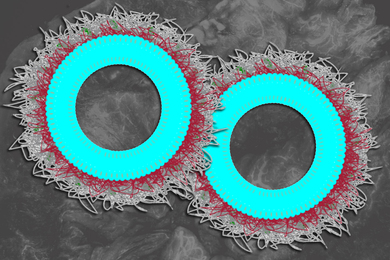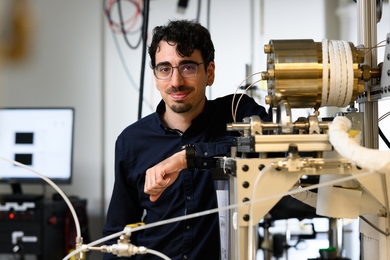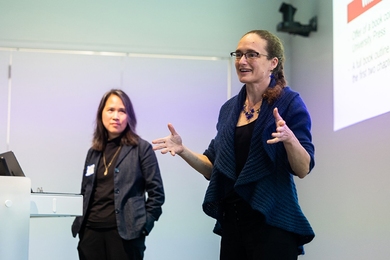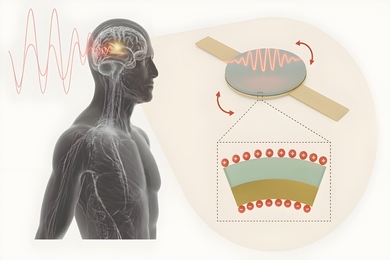MIT today announced the launch of an “Innovation Node” in Hong Kong, a collaborative space that aims to connect the MIT community with unique resources — including advanced manufacturing capabilities — and other opportunities in Hong Kong and the neighboring Pearl River Delta (PRD).
Set to launch next summer, the MIT Hong Kong Innovation Node will convene MIT students, faculty, and researchers to work on various entrepreneurial and research projects alongside Hong Kong-based students and faculty, MIT alumni, entrepreneurs, and businesses. By combining resources and talent, the Innovation Node aims to help students learn how to move ideas more rapidly from lab to market.
Other new activities enabled through the Innovation Node will include: increased opportunities for MIT students to conduct research in collaboration with Hong Kong universities; events focused on innovation and entrepreneurship; internships at companies in the region; and the formation of a makerspace and startup programs for student entrepreneurs.
The Innovation Node, conceived and run by the MIT Innovation Initiative, is expected to launch with an initial cohort of MIT students traveling to Hong Kong in July to work on various projects and participate in workshops with local students. A search is under way for a Hong Kong-based executive director. Initial funding for the node has been provided by Hong Kong-based MIT alumni and other friends of the Institute.
The announcement was made today by MIT President L. Rafael Reif, who is visiting Hong Kong this week with a delegation from MIT. Among guests at an MIT reception to introduce the node were prominent local alumni, educators, and Hong Kong government officials.
“By bringing MIT to Hong Kong and Hong Kong to MIT, the Innovation Node will deepen MIT’s activities in Hong Kong and, through Hong Kong, in the entire Pearl River Delta region,” Reif said. “In creating this node in Hong Kong, MIT is committing to advancing our engagement with the region in a mutually beneficial way.”

Hong Kong and MIT more tightly joined: (left to right) Victor Fung SM ’66, MIT President L. Rafael Reif, and MIT Professor Charles Sodini.
Activities carried out by the Innovation Node will be overseen by a steering committee of MIT faculty and administrators, including: Charles Sodini, the Clarence J. LeBel Professor in Electrical Engineering, who will also serve as faculty director for the node; Innovation Initiative co-directors Fiona Murray, the Bill Porter Professor of Entrepreneurship, and Vladimir Bulović, the Fariborz Maseeh Professor of Emerging Technologies and professor of electrical engineering; and Yasheng Huang, the International Program Professor in Chinese Economy and Business and associate dean for international programs and action learning at the MIT Sloan School of Management. Richard Lester, associate provost for international activities and the Japan Steel Industry Professor in the Department of Nuclear Science and Engineering, will chair the steering committee.
"In preparing for a career in today’s global innovation economy, MIT’s students need an education that presents a global outlook on the challenges and opportunities in innovation and entrepreneurship," Murray says. "Building on MIT’s long record of engagement in Hong Kong and mainland China, the Innovation Node will allow many different MIT programs to imagine week, month, and summer-long experiences that enrich education, research, and our connection to real-world opportunities for impact."
The node will be advised in Hong Kong by a local group of MIT alumni that will help coordinate programs for current MIT students, alumni, and the local community.
Fast manufacturing
In addition to the presence of strong research universities, a major reason why MIT chose to establish an Innovation Node in Hong Kong is because it provides ready access to a unique manufacturing infrastructure that encourages rapid prototyping and scale-up, Sodini says.
About an hour’s commute from Hong Kong’s Central District lies Shenzhen, a city home to many scientists and engineers — and fast, low-volume manufacturing. “Manufacturers in Shenzhen have mastered the ability to take a prototype device to unit quantities of hundreds overnight,” Sodini says. “This unparalleled speed of small quantity manufacturing is unique to Shenzhen.”
MIT students will learn hands-on lessons in designing and manufacturing for commercialization, Sodini says: “Giving our students access and experience with this capability educates them in how to move more quickly from idea to product.”
Through the node, students will also be linked to opportunities along the Greater Pearl River Delta, a network of roughly a dozen major cities in southern China — including Hong Kong and Shenzhen — that serve as innovation hubs and economic drivers for the country.
Many MIT-based startups, in fact, already travel to Hong Kong and the Pearl River Delta region to prototype and produce devices, MIT Provost Martin Schmidt says. “Having a connection to this region will strengthen this access, and will open opportunities to develop new enterprises in the region,” he says.
Victor K. Fung SM ’66, one of several Hong Kong alumni on the local advisory group for the Innovation Node, said that the new model for Hong Kong-PRD partnership is one of collaborating far higher up the supply chain, at the early stages of innovation, where ideas for products or services are conceived, prototyped, and iterated.
“With this node,” Fung says, “MIT is bringing its cutting-edge learning and research programs to global innovation’s new frontier. This is an exciting and highly significant development.”
Node activities
The MIT Hong Kong Innovation Node builds on more than 20 years of collaborations between MIT and Greater China. These have included partnerships between MIT and several Hong Kong universities, including the Hong Kong University of Science and Technology, the University of Hong Kong, and the Chinese University of Hong Kong.
Initially, the Node will carry out numerous activities to boost the innovative and entrepreneurial capabilities of MIT students, faculty, researchers, and alumni, in collaboration with the Hong Kong community. These include:
- Internship opportunities: Facilitating internships for MIT students at companies in Hong Kong and Shenzhen, and along the Pearl River Delta through the China program of the MIT International Science and Technology Initiatives (MISTI).
- Educational programs: Weeklong or longer workshops, where MIT and local innovators can work together on venture-building activities in global contexts. MIT centers and programs such as the Martin Trust Center for MIT Entrepreneurship will run these programs.
- Engagement opportunities: Expand the current “action-learning” activities for students and student teams through the MIT China Lab, which pairs MIT Sloan students with students from top business schools in China.
- Innovation-focused events: Weekly or monthly events will convene MIT-affiliated partners of the Node, such as the MIT Club of Hong Kong, MIT’s Industrial Liaison Program, and the MIT Technology Review for innovation-focused programming.
In the future, organizers also plan to create in the Hong Kong node what is known as a “makerspace”: a facility equipped with advanced tools and materials for invention and prototyping. MIT is currently in the process of building a new makerspace on its Cambridge campus that will be linked to the node’s proposed makerspace. The spaces will be equipped with similar tools and offer the same training.
The idea is to facilitate a way for MIT and Hong Kong students to collaborate physically or virtually — through advanced telecommunication services — to drive ideas toward commercialization. For instance, medical devices, sensors, or robotics could be prototyped on the MIT campus or at the node, tested in the Boston or Hong Kong regions, and have small quantities manufactured in Shenzhen.










